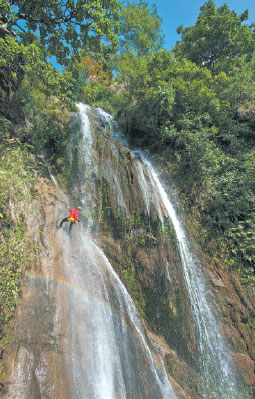Canyoning becomes popular in Nepal
(China Daily) Updated: 2017-06-19 07:03NUWAKOT, Nepal - Bulbule Waterfall located in Nuwakot district, about 35 kilometers away from Nepal's capital Kathmandu, was once known as a place for taking cool baths during the summer.
But as soon as the Nepal Canyoning Association explored the 40-meter high waterfall, the place turned into a canyoning destination.
On a recent weekend, over 150 Nepalese and foreign visitors were in Bulbule as part of the 3rd National Canyoning Rendezvous 2017.
The canyoning fiesta was not just about sliding down a rope through a waterfall to a pool below, but included hiking, scrambling, abseiling, jumping and swimming.
"Nepal is blessed with thousands of rivers and waterfalls, but we have not been able to utilize them fully. We want to develop and promote canyoning destinations and make Nepal the best spot for adventure tourism," says Rajendra Lama, the president of the Nepal Canyoning Association.
Though canyoning has been gaining in popularity in Nepal since 2002, it gained official recognition and an organizational structure only in 2007 after the setting up of the Nepal Canyoning Association.
Today, there are more than 70 travel agencies under the association, and more than 30 canyons have been explored across the country.
Travel agencies provide canyoning packages in mountainous districts like Sindhupalchowk, Kavre, Nuwakot, Lamjung and Syangja.
Within Kathmandu valley, canyoning activities are available in Sundarijal, in the lap of Shivapuri National Park.
The Himalayan nation is regarded as the second-richest country after Brazil in water resources as it has more than 6,000 rivers, lakes, ponds, waterfalls and springs. But despite such resources, adventurers complain that the adventure activities available are mostly limited to boating and rafting.
Karna Bahadur Lama, the general secretary of the Trekking Agencies Association of Nepal, says: "Nepal has a unique geography and richness in natural resources. And since tourism is the backbone of the country's economy, we need to tap into the opportunities to attract more foreign tourists."
In 2016, earthquake-ravaged Nepal attracted 729,550 foreign tourists, which is 24 percent more than 2015, the year of the devastating earthquake.
With tourism gradually recovering, entrepreneurs say that activities like canyoning can be a great way to attract and engage foreign tourists.
Canyoning is equally popular with Nepali youngsters. One of the major reasons for its growing popularity is social media, says the Nepal Canyoning Association.
"When we put out posts about the canyoning festival on social media, we received a huge amount of feedback and response from youngsters. Social media is a powerful tool for tourism promotion," the canyoning association president Lama says.
Nepal's canyoning follows international standards. There are more than 30 professional instructors in the country who have received training from American and French professionals, and who are familiar with the country's streams.
During the recent canyoning festival, more than a dozen instructors and volunteers handled the navigation and facilitated the outdoor activities.
While it was the first canyoning experience for most of the participants, they say that it is an unforgettable experience.
"It is the experience of a lifetime. I was scared initially but with proper instructions I got down safely. I would like to do it again," says 22-year-old student Sarose Chaudhary.
Xinhua
|
A woman rappels down a waterfall during a canyoning excursion in Nepal, blessed with rich resources of rivers and waterfalls. Provided To China Daily |
- 'Cooperation is complementary'
- Worldwide manhunt nets 50th fugitive
- China-Japan meet seeks cooperation
- Agency ensuring natural gas supply
- Global manhunt sees China catch its 50th fugitive
- Call for 'Red Boat Spirit' a noble goal, official says
- China 'open to world' of foreign talent
- Free trade studies agreed on as Li meets with Canadian PM Trudeau
- Emojis on austerity rules from top anti-graft authority go viral
- Xi: All aboard internet express












